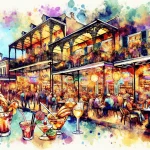The Allstate Sugar Bowl, a premier college football event, has been a cherished New Year’s tradition in New Orleans since 1935. This iconic bowl game showcases elite teams from the SEC and Big 12 conferences, drawing thousands of enthusiastic fans to the captivating city of New Orleans annually.
In This Article
TL;DR
- The Allstate Sugar Bowl is a prestigious annual college football game held in New Orleans, Louisiana.
- The event significantly impacts New Orleans‘ culture and economy, attracting a substantial influx of visitors.
- The Sugar Bowl boasts a rich history, featuring memorable games and moments that have contributed to the fabric of college football and sports culture.
The History and Significance of the Allstate Sugar Bowl
The Sugar Bowl’s origins can be traced back to 1890 when the first New Orleans Football Classic was played. However, it wasn’t until 1935 that the Sugar Bowl as we know it today was established. The inaugural game featured Tulane University and Temple University, with Tulane emerging victorious 20-14.
Over the years, the Sugar Bowl has hosted numerous notable games and moments. In 1956, the game featured a matchup between the Georgia Tech Yellow Jackets and the Pittsburgh Panthers, with Georgia Tech winning 7-0 in a defensive battle. The 1973 Sugar Bowl saw Notre Dame defeat Alabama 24-23 in a thrilling contest that is still remembered as one of the greatest college football games ever played.
The Sugar Bowl has made significant contributions to college football and sports culture. It has provided a platform for talented players to showcase their skills on a national stage and has helped elevate the profiles of participating schools. The event has also played a role in shaping the college football playoff system and has been a key factor in determining national championships.
Planning Your Visit to the Sugar Bowl
To secure tickets for the Allstate Sugar Bowl, it’s best to purchase them well in advance through the official Sugar Bowl website or authorized ticketing partners. Accommodation options in New Orleans during the event can be limited, so it’s advisable to book hotels or vacation rentals early to ensure availability and competitive rates.
When navigating New Orleans during the Sugar Bowl, consider using public transportation or ride-sharing services to avoid traffic congestion. The New Orleans Regional Transit Authority (RTA) offers bus and streetcar services that can help you get around the city efficiently. Taxis and ride-sharing apps like Uber and Lyft are also widely available.
The Mercedes-Benz Superdome, where the Sugar Bowl is held, has strict safety and security measures in place. Attendees are subject to security screenings and bag checks before entering the stadium. It’s important to review the Superdome’s policies regarding prohibited items and to arrive early to allow sufficient time for security procedures.
Experiencing New Orleans During the Sugar Bowl
New Orleans comes alive during the Sugar Bowl, with a festive atmosphere that extends beyond the football field. The city’s famous French Quarter bustles with activity, featuring live music, street performers, and vibrant nightlife. Visitors can explore iconic attractions like Bourbon Street, Jackson Square, and the French Market.
For a taste of New Orleans’ renowned cuisine, head to local favorites like Café du Monde for beignets, Dooky Chase’s Restaurant for Creole dishes, or Acme Oyster House for fresh seafood. The city’s culinary scene is a delightful blend of Cajun, Creole, and Southern influences, offering a wide range of flavors to savor.
Other popular activities during the Sugar Bowl include taking a steamboat cruise on the Mississippi River, visiting the National WWII Museum, or exploring the historic Garden District. The Mardi Gras World museum offers a behind-the-scenes look at the city’s famous Carnival celebration, with exhibits showcasing colorful floats and costumes.
The Economic Impact of the Sugar Bowl on New Orleans
The Allstate Sugar Bowl generates significant economic benefits for the local community. The influx of visitors during the event boosts tourism, with fans filling hotels, restaurants, and attractions. This increased spending supports local businesses, creates jobs, and generates tax revenue for the city.
According to a study by the University of New Orleans, the 2020 Sugar Bowl had an estimated economic impact of $200 million on the local economy. This includes direct spending by visitors on accommodations, dining, entertainment, and transportation, as well as indirect and induced effects on the broader economy.
The Sugar Bowl’s economic impact is comparable to other major events in New Orleans, such as the Essence Festival and the New Orleans Jazz & Heritage Festival. These events collectively contribute to the city’s thriving tourism industry and help support the livelihoods of many local residents.
Engaging with the Community and Cultural Events
The Allstate Sugar Bowl is more than just a football game; it’s an opportunity to engage with the local community and participate in cultural events. The Sugar Bowl Committee organizes various charitable initiatives and community outreach programs throughout the year, including youth football clinics and educational scholarships.
During Sugar Bowl week, visitors can enjoy a range of cultural performances and exhibitions that showcase the rich heritage of New Orleans. The Allstate Sugar Bowl New Year’s Eve Parade features colorful floats, marching bands, and costumed performers, providing a festive prelude to the big game. The Fan Fest, held in the days leading up to the Sugar Bowl, offers interactive exhibits, live entertainment, and opportunities to meet college football legends.
To fully immerse yourself in the local culture, consider attending events like the Sugar Bowl Street Fest, which features live music, food vendors, and artisan crafts. The Allstate Sugar Bowl New Year’s Eve Gala is another highlight, offering an elegant evening of dining, dancing, and entertainment.
Insider Tips for Enjoying the Sugar Bowl
To make the most of your Sugar Bowl experience, here are some insider tips:
- Arrive early on game day to enjoy the pregame festivities and avoid last-minute crowds
- Dress in layers, as weather in New Orleans can be unpredictable during the winter months
- Take advantage of the city’s walkability and explore the French Quarter on foot
- Sample a variety of local cuisines, from po’boys and gumbo to pralines and king cake
- Engage with locals and participate in traditions like the “second line” parade or the “Who Dat” chant
For a unique perspective on the Sugar Bowl, consider taking a behind-the-scenes tour of the Mercedes-Benz Superdome. These tours offer a glimpse into the stadium’s history, architecture, and inner workings, providing a deeper appreciation for the event’s significance.
Future of the Allstate Sugar Bowl
As the Allstate Sugar Bowl looks to the future, there are exciting developments and potential enhancements on the horizon. The event continues to adapt and evolve to meet the changing landscape of college football and the expectations of fans.
One trend to watch is the increasing integration of technology and innovation to enhance the visitor experience. From mobile ticketing and cashless concessions to augmented reality displays and interactive fan zones, the Sugar Bowl is embracing digital solutions to create a more seamless and engaging event.
The Sugar Bowl Committee also remains committed to its partnerships with the SEC and Big 12 conferences, ensuring high-quality matchups and competitive games in the years to come. As the college football playoff system continues to evolve, the Sugar Bowl’s role and significance within that structure may also adapt.
Ultimately, the future of the Allstate Sugar Bowl is bright, with a strong foundation of tradition, community support, and a dedication to providing an unforgettable experience for college football fans in the captivating city of New Orleans.






